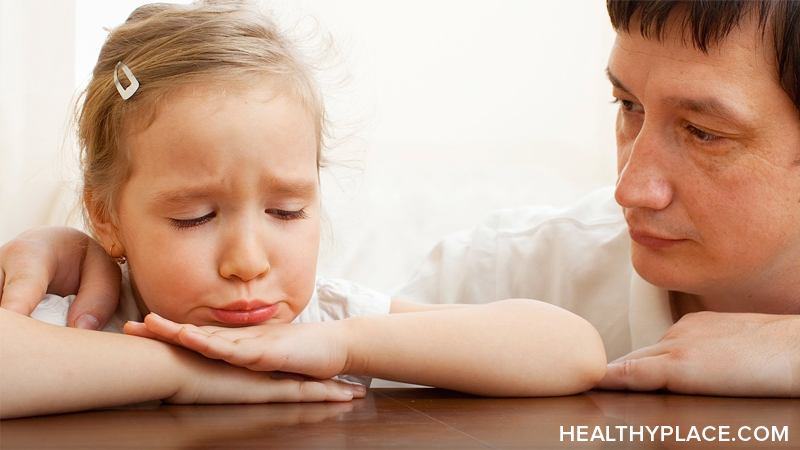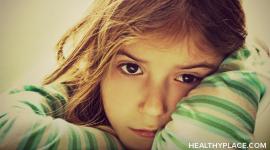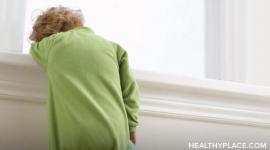Social Anxiety in Children: Helping Children with Social Phobia

Social anxiety, also known as social phobia, commonly begins at age 10. While some people think social anxiety in children is simply "extreme shyness," this is not the case. Social phobia (anxiety) in children is a recognized mental disorder and goes beyond mere shyness (read The Shy Child: How to Help Your Child Overcome Shyness).
According to the latest version of the Diagnostic and Statistical Manual of Mental Disorders (DSM-IV-TR), the criteria for social anxiety in children includes:1
- Distinct and persistent fear of one or more social or performance situations with peers
- Exposure to feared situation produces anxiety. In children with social anxiety this may be tantrums, crying, freezing or shrinking away.
- Feared situations are avoided
- The social anxiety symptoms interfere with normal day-to-day life
- The duration is longer than six months
Social phobia in children is also related to selective mutism; where a child cannot or will not talk in certain situations.
The causes of social phobia in children are unclear; only theories are currently available. Social anxiety in children may be due to:
- Dysfunction in the pathways of the brain chemical serotonin
- Dysfunction in a part of the brain known as the amygdala
Medications for Treatment of Children with Social Anxiety (Social Phobia)
The most important thing any parent concerned about social phobia in children can do is get a professional assessment. Only a mental health or health professional can decide what type of treatment is best for a child with social anxiety. Untreated childhood social phobia often continues into adulthood and may be a precursor to agoraphobia.
Often a combination of medication and therapy is used to treat children with social anxiety. No medication is FDA-approved for social anxiety treatment in children. However, medications approved for adults are sometimes used off-label to treat children. Common medications used in social anxiety disorder treatment include:
- Paroxetine (Paxil) – an antidepressant FDA-approved for social anxiety treatment in adults and considered a frontline treatment in adults.
- Sertraline (Zoloft) – an antidepressant FDA-approved for short- and long-term treatment of social anxiety in adults. Also approved for the treatment of obsessive-compulsive disorder in children older than 12.
- Venlafaxine (Effexor) – an antidepressant FDA-approved for treatment of social anxiety in adults.
- Benzodiazepines – used in some anxiety disorders when antidepressants cannot be taken; not approved for social anxiety disorder, specifically, but some are approved for use in children.
When using antidepressants, it's always important to carefully observe any child as antidepressants may increase suicidal thoughts or self-harming behavior in children.
Therapy for Social Anxiety Disorder in Children
Therapy may be used to treat social phobia in children alone or with medication. Most therapies have been studied in adults, but some, like cognitive therapy, have been proven useful in adolescents. Play therapy is often indicated for young children with social anxiety.
Additional types of therapy used in treating social anxiety include:
- Behavioral – such as gradually introducing the feared situation (desensitization)
- Computerized cognitive behavioral therapy
- Insight-oriented therapies – may be useful in older children
- Stress management and relaxation techniques
Tips for Parenting a Child with Social Anxiety
The first thing to remember is that social anxiety in children is not an indicator of bad parenting. While stress at home can add to social anxiety, no one action can cause social anxiety in a child.
Psychologist Lynn Siqueland, Ph.D., specializes in treating children and adolescents with social anxiety disorder and has the following tips for parents:2
- Set expectations for an anxious child the same way you would for any other child; however, understand the pace may be slower and it may require more work to get there.
- Build your child's personal strength through praise and finding things at which they excel. Also have them do jobs around the house so they know they are contributing to the household.
- Don't continually reassure the child; let them learn by doing things on their own. Teach a child to answer his own questions and show you believe in them.
- Allow your child to feel and express their emotions, including anxiety without the fear of reprisals.
- Keep your own fears to yourself and let your child know it's safe to explore the world around them.
- Work together with other caregivers so the child gets a consistent message.
- Set limits and consequences for inappropriate behavior – don't confuse anxiety with other actions.
APA Reference
Tracy, N.
(2021, December 21). Social Anxiety in Children: Helping Children with Social Phobia, HealthyPlace. Retrieved
on 2025, March 28 from https://www.healthyplace.com/anxiety-panic/anxiety-and-children/social-anxiety-in-children-helping-children-with-social-phobia


